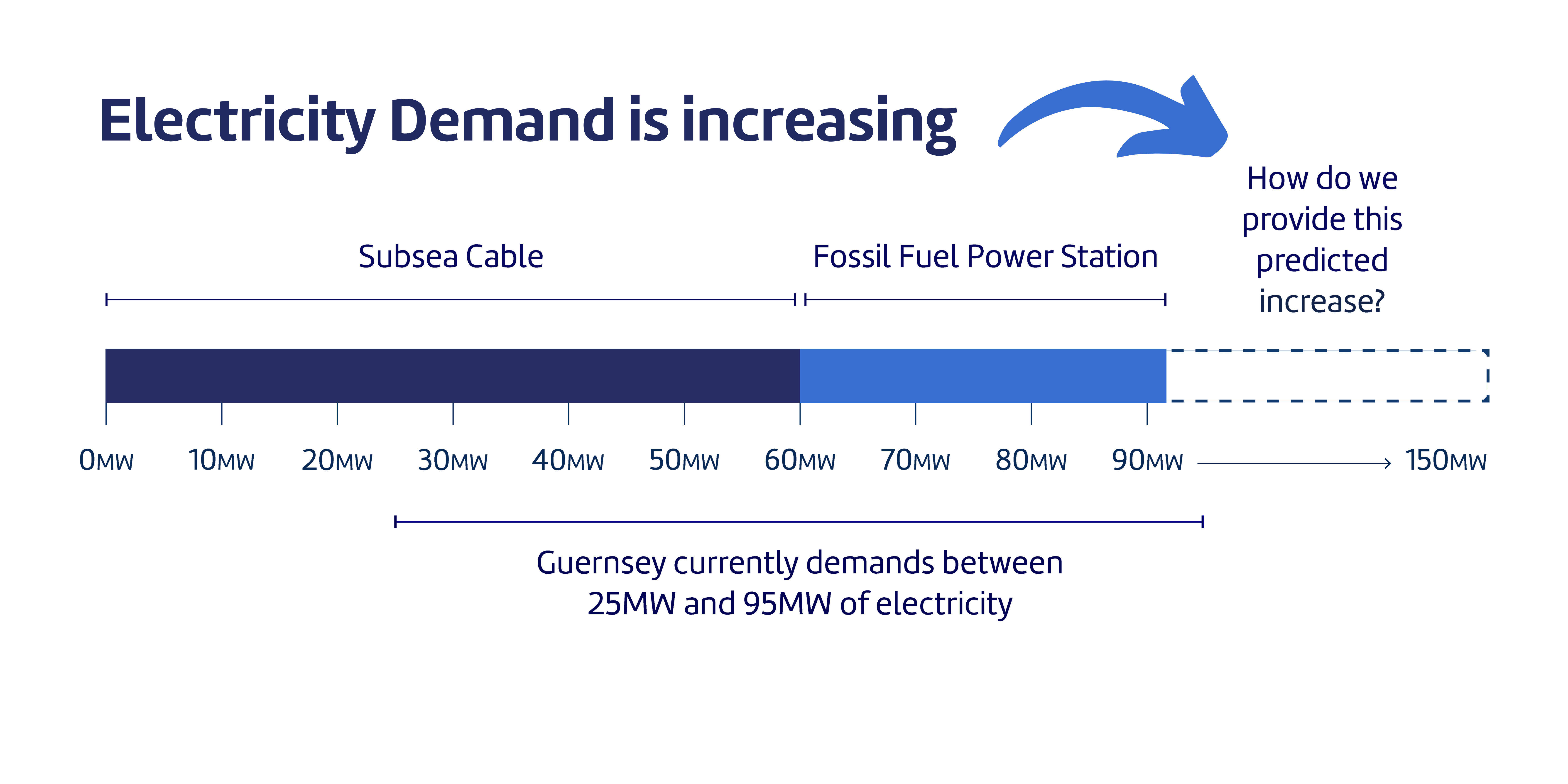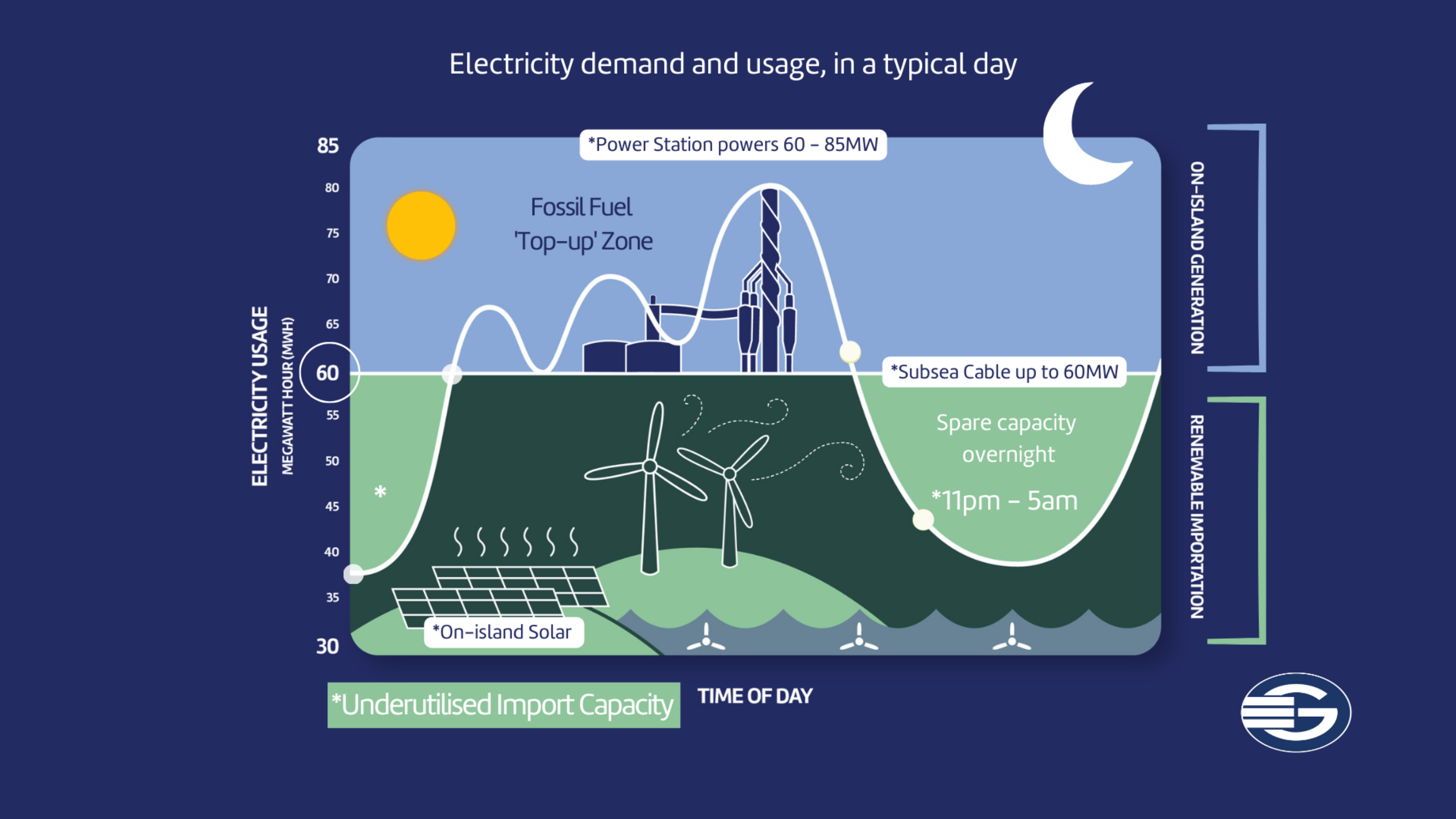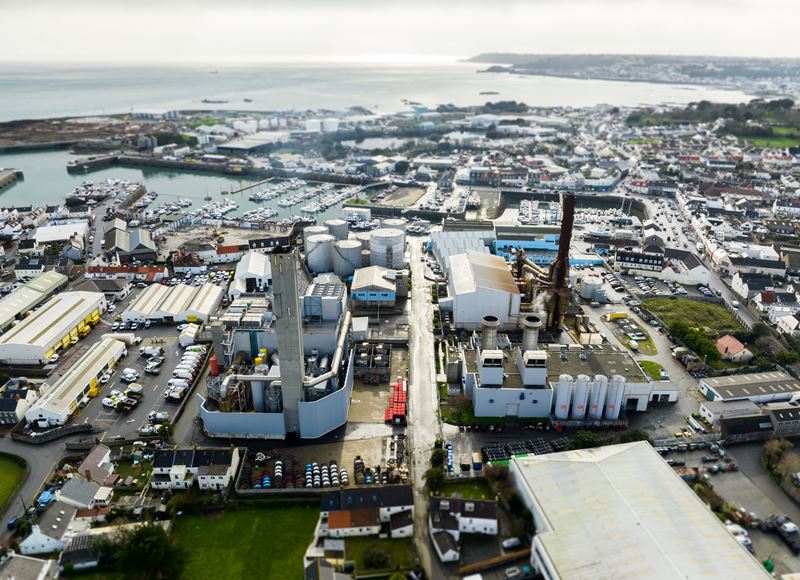The evolution of our power station

Guernsey used to rely on the fossil-fuel power station for all our electricity, but since 2000 the subsea cable connecting the Island to Europe has been our primary source of electricity, which has also dramatically reduced our carbon emissions.
However, when our power demand exceeds 60 Megawatts (which is what we can currently import through the cable), we make up the difference by ‘topping-up’ our electricity supply using the power station, which comes with both environmental and financial costs.
Around the world, Governments are beginning to implement policies that will phase out the use of more polluting forms of heating and transport. This means the phasing in of electric-powered alternatives, which is predicted to result in an increased demand for electricity.
In Guernsey, demand is predicted to increase to a peak of up to 150MW by 2050. The States Electricity Strategy will set out how we aim to meet this increase in a sustainable way. Without these key decisions, we will need to invest more in the fossil-fuel power station to help meet increased electricity demand.

Renewable energy generation in Guernsey can and should feature as part of the future supply mix but, given its variability associated with fluctuating wind and sunlight, we need other forms of dependable power generation to work alongside renewable sources.
Generating from the power station is dependable, but significant upgrades are required imminently. As one of the most carbon emitting sources, it brings significant financial and environmental costs, threatening our ability to meet net zero.
Demand for electricity is predicted to increase. Phasing out petrol and diesel vehicles and fossil fuel heating means the phasing in of electric-powered alternatives. At the moment, as we have no other option, this change means we’ll be using the power station more. See for yourself the challenging road ahead to net zero and find out why agreeing the Electricity Strategy is so crucial to our next steps.
What is the role of the power station?
The power station in Guernsey currently exists to provide two important functions.
Firstly, it provides a ‘top-up’ service to ensure there is enough power generated to meet the Island’s needs. The majority of our power is imported via the subsea cables connecting Guernsey to Jersey and Jersey to Europe. However, the single connection between Guernsey and Jersey is not big enough to provide all our power requirements all the time. Throughout the summer there is almost always enough capacity in the cable, so the power station rarely runs.
However, through the winter, the cable is not sufficient to meet the Island’s needs, particularly during peaks. To meet any shortfall, the power station generators are used.

The second key function of the power station is to provide a back-up in the event that the import cables become unavailable. The power station needs to be able to supply the whole Island on a continual basis if required. To achieve this, it remains on standby and has high levels of resilience built in. Keeping it ready for use in an emergency takes lots of investment and maintenance.
Guernsey Electricity’s ‘C station’ houses four of the Vale Power Station’s ten generators, and all four are now at or approaching the end of their service life. With the older generators still a key part of our back-up provision, we need to spend money on them to ensure they remain available for service. Due to their age, this is now becoming a riskier option and they may not be maintainable for much longer.
The extent to which these generators are replaced, and the type of equipment they are replaced by, is highly dependent upon the Island’s Electricity Strategy, and particularly whether Guernsey invests in additional interconnection or not. A second interconnector (subsea cable) substantially changes the risks we need to plan for and therefore the level of security of supply we hold on-Island.
How do we propose to power the future sustainably?
Guernsey can secure low carbon electricity through the addition of a second interconnector. This not only meets the increasing demand for electricity using low carbon sources, but it is essential to help facilitate the integration of large-scale local renewables such as solar PV and offshore wind by keeping the system in balance whilst the output of renewable energy generation varies with the wind and sun.
We need time to facilitate an increase in solar PV capacity, and to plan and develop other renewable energy generation - a second cable buys this time. With the additional capacity and security of supply that a second link to Europe provides, we do not need to invest anywhere near as much in back-up fossil fuel generators at the power station. The power station would no longer be our primary back-up and top-up option for providing electricity on demand but would remain a key feature of our power system in the long term.
This approach offers far better value, both financially for consumers and for the environment.
How long will this take?
The energy transition is not an overnight phenomenon. Whilst governments can set policies and technologies can alter preferences, ultimately the energy transition is a societal change in the way consumers source and use energy – and it’s already underway.
Consumers are choosing electric transport, choosing to install solar arrays, and choosing to replace their gas or oil boiler with electric. The technology is becoming more readily accessible and as consumers we, more than ever before, will play our part in the energy transition.







